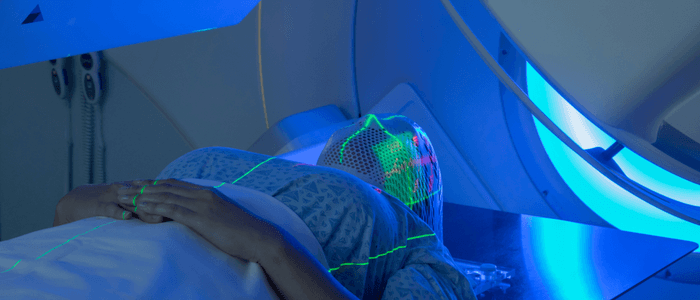
Introduction:
Mind-boggling change has happened the way radiation therapy is given to a patient. Advances in computerization, imaging with MRI/PET-CT, automation, and incorporation of artificial intelligence have dramatically decreased the possibility of side effects, especially the side effects that were happening years later (late side effects).
What is the difference between 2D, 3DCRT, IMRT, and IGRT?
Before 2000 radiation treatment used to be a simple arrangement given from 2 to 4 directions. Fig 1 to 3 shows the example of treatment evolution for cancer in the head and neck region. Three critical parts in this region are two parotid salivary glands on either side of the face, jawbone, and spinal cord behind. In the cured patients, the major problem is the development of total dryness of the mouth, giving a lot of distress. Side effects of the jawbone, the spinal cord was also higher.
Fig 1: Showing the full dose to the parotid glands and maximum dose to the spinal cord.
Fig 2: At around the year 2000, we were able to shape the beam to an extent.
The development was 3-Dimensional Conformal Radiotherapy (3 DCRT) and reduced the dose to at least part of the parotid gland and other vital organs. This change was possible with many smaller beams sent from different directions. Both 2D and 3DCRT are planned manually.
Fig 3: Later, the quantum leap in technology and we were able to bend the area of radiation the way we wanted by attaining the curving of dose delivery volume, as shown in the figure.
The dose received by the parotid, jawbone, and spinal cord came down dramatically, hence the drastic reduction in long-term side effects. This computerized automated technology is the Intensity Modulated Radiotherapy (IMRT). This “concavity” is possible by sending more than 100 beams in such a way that it goes through the planned treatment area but the “computer system” blocks the radiation when it sees a critical organ in its path. Comparing IMRT and another technique, IGRT (Image Guided Radiotherapy), both are the same in terms of how radiation is planned, as shown in the above figure. In the case of IMRT, two x-rays (one from the front and the other from the side) are taken, the position of the table is corrected to precision, and then the treatment is given as the patient is sleeping on the treatment table (couch). In IGRT, a CT scan by the treatment machine is taken, position corrected to precision, and the treatment given. This CT scan is for positioning the patient precisely and detecting prominent findings and is certainly not meant for evaluation of fine changes in the cancer response.
TrueBeam STx, Tomotherapy, Vmat are the types of machines that deliver IMRT/IGRT.
The above figures are one example to understand the way it works. Depending on the cancer site, the critical tissues around the cancer are protected by IMRT/IGRT technology with its ability to give concave and convex distribution. Additionally, in radiation therapy, just by reducing the volume of tissues treated, the side effects come down dramatically even for less critical tissues. Radiation therapy technology is the second medical therapy field where robotics and AI (artificial intelligence) are playing increasing application next only to Robotic surgery.
Which one to Choose? IMRT or IGRT?
In a practical setting, there is a lot of difference between 3DCRT vs. IMRT/IGRT, but a marginal difference between IMRT vs. IGRT. Therefore, nowadays, we offer minimum IMRT technique (except in few situations), and the patients who want the best available technology can go for IGRT. One need not worry later about not choosing IGRT since IMRT or IGRT are acceptable as per guidelines. However, IGRT is a must when treating:
Note: In our protocol, once a week, we do IGRT in the IMRT treatment package.
Another significant improvement in the treatment is positioning the patient in the radiation beam path. Cancer Therapy India has a TrueBeam STx machine (by Varian Company) with a robotic table (couch) positioning system where precision becomes slightly higher for IMRT and IGRT.
What is Forward IMRT?
When IMRT is manually planned (not automated computer method) and is called “Forward IMRT.” It’s a hybrid of 3DCRT and IMRT. As per the international recommendation and guidelines, cancer of the breast should be treated by this technique. In the breast cancer of the left side, this “Forward IMRT” should be given during the deep inspiration position (Deep Inspiratory Breath Hold – DIBH technique).
What is SRS/SBRT/SABR?
When IGRT is focused with hundreds of beams and adopted with knowledge of the position of cancer movement of cancer within the body (stereotaxic technique), it is called SBRT (Stereotactic Body Radiotherapy)/SRS (Stereotactic Radio Surgery)/SABR (Stereotactic Ablative Body Radiotherapy). SBRT/SRS/SABR is usually given over 1 to 5 sittings when surgical removal is not possible. TrueBeam STx, Cyberknife, etc., are the machines used here.
Cancer Therapy India is among the best cancer hospital in Bangalore having a team of leading oncologists and cancer specialist in Bangalore, trained extensively in the US, UK, and India. They are experts in providing different cancer therapies to the patients and also guide them to stay strong during and after the treatment.
The best IGRT radiotherapy in Bangalore can be availed at Cancer Therapy Hospitals at a highly affordable cost, as compared to the rest of the medically advanced countries and cities in India. Cancer Therapy’s best hospitals are equipped with all the modern and world-class facilities, medical technology, and equipment used to deliver quality cancer treatment to patients from around the country. Our radiation oncology department has an advanced machine for IMRT in Bangalore which is widely used in clinical applications for the treatment of malignant and non-malignant diseases.